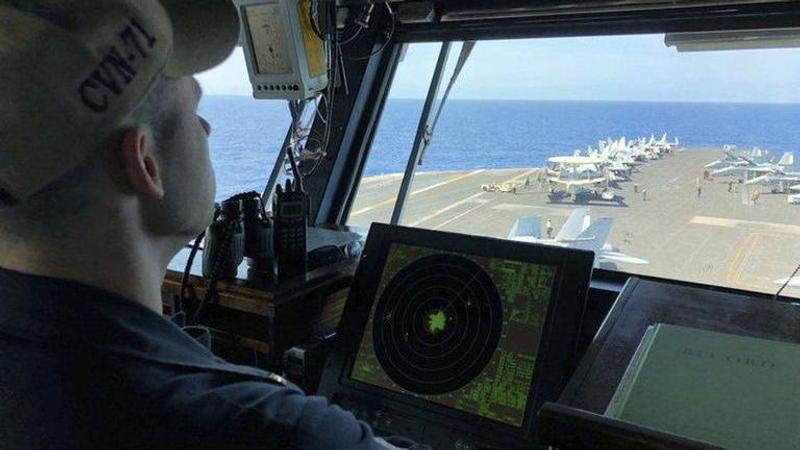Published 10:50 IST, March 9th 2020
Recent developments surrounding the South China Sea
A look at recent developments in the South China Sea, where China is pitted against smaller neighbors in multiple territorial disputes over islands, coral reefs and lagoons. The waters are a major shipping route for global commerce and are rich in fish and possible oil and gas reserves.

A look at recent developments in the South China Sea, where China is pitted against smaller neighbors in multiple territorial disputes over islands, coral reefs and lagoons. The waters are a major shipping route for global commerce and are rich in fish and possible oil and gas reserves.
CHINA DISPUTES U.S. ACCUSATION OF FIRING LASER AT PLANE
China's Defense Ministry says a report that one of its navy ships fired a laser at a U.S. Navy surveillance plane last month does not “accord with reality."
The report last month was the latest accusation that Chinese forces have used lasers to harass and potentially damage U.S. and other nations' military aircraft and personnel.
However, ministry spokesman Ren Guoqiang was quoted as saying Friday that the ministry “refuted" the report and said a Chinese squadron was conducting routine exercises in international waters on Feb. 17 when the incident allegedly happened.
In China's first public comments on the alleged incident, Ren accused an American P-8A Poseidon of carrying out “long-period circling reconnaissance at low altitude despite repeated warnings from the Chinese side."
The U.S. accused the Chinese ship of firing a laser at a U.S. surveillance aircraft flying over the Philippine Sea west of Guam that was detected by sensors on the aircraft.
U.S. CARRIER VISIT TO VIETNAM MARKS GROWING SECURITY TIES
The USS Theodore Roosevelt made the second-ever visit by a U.S. aircraft carrier strike group to Vietnam to mark 25 years of diplomatic relations and growing security ties between the former Cold War antagonists amid China's aggressive moves in the South China Sea.
The U.S. considers the Vietnamese to be “trusted partners and our friendship is grounded in mutual respect," U.S. Navy Admiral and Commander of the U.S. Pacific Fleet John C. Aquilino told reporters Friday.
Relations with countries such as Vietnam form the basis of what the U.S. calls its “free and open Indo-Pacific strategy," ensuring maritime freedoms and the continuing presence of the U.S. Navy to check China's ambitions to dominate islands and seas in the western Pacific and extend its influence into the Indian Ocean. The U.S. has been making port calls to Vietnam since 2003.
JAPAN, VIETNAM AGREE TO BOOST SECURITY COOPERATION
Japan and Vietnam have agreed to boost their security cooperation in a move likely to be viewed critically in Beijing.
The chief of staff of Japan's defense forces, Koji Yamazaki, met with his Vietnamese counterpart, Ngo Xuan Lich, last week in Hanoi and called Vietnam a “highly important partner" for Japan, according to Japanese broadcaster NHK. It quoted Lich as saying the visit would “help boost defense ties," but gave no specifics.
Vietnam hotly contests China's claim to the Paracel and Spratly island groups and has brought out its maritime security forces to harass Chinese state-sponsored petroleum prospecting missions. China seized Vietnamese territory in the South China Sea with armed force and the memory of that bloodshed, coupled with centuries of Chinese political domination, remains strong among the Vietnamese public, despite efforts by the government to maintain cordial relations with Beijing.
China, meanwhile, objects strongly to the presence of the Japanese navy in the region, regarding it as merely a cat's paw for the U.S., with which Japan has a mutual defense treaty.
IMPROVEMENTS ON PHILIPPINE ISLAND PROGRESS DESPITE CHINESE PRESENCE
Researchers say China's maritime militia has constantly lingered around Thitu Island, the largest of the Spratly Islands occupied by the Philippines, for over 450 days, but that Manila is proceeding with improvements to the island's infrastructure.
China first deployed its militia vessels — mainly converted fishing ships — in December 2018 after Manila began work to repair the island's runway and make further improvements.
A news release from the Center for Strategic and International Studies' Maritime Transparency Initiative said the runway repairs are continuing slowly and a small harbor is being formed to improve the quality of life for the island's civilian population, mainly fishermen. That will also help facilitate resupply and other planned construction like a desalination plant, solar arrays and improved housing. That could also allow Philippine authorities to deploy vessels in rotation to the island that China claims as its own.
“How the Chinese militia would respond, and whether they will continue to menace Thitu once the repairs are complete, are open questions," the report said.
NEW RESEARCH BLAMES CHINA FOR REEF DAMAGE
Reefs in the South China Sea are in worse danger than ever before acknowledged, largely due to Beijing's military buildup and over-fishing by Chinese vessels, according to researchers from James Cook University in Australia.
Dredging to construct China's new islands has damaged the environment and there are typically 100-150 Chinese fishing boats working every reef that China controls, compared to between 0.1 and 0.5 fishing boats per reef in the Great Barrier Reef, according to the research by Eric Wolanski and Severine Chokroun.
Their report said those activities have severely reduced the amount of coral larvae and the fish that depend on them. Research is hampered because China does not provide scientists with access to the reefs it occupies or provide data on the health of coral and fish populations.
“We recognize the political difficulties, but we have defined the problem and we have the solution based on the example of the developing collaboration between the Philippines and Vietnam that manages some reefs in the archipelago,” Wolanski was quoted as saying by the university late last month.
Updated 10:50 IST, March 9th 2020




